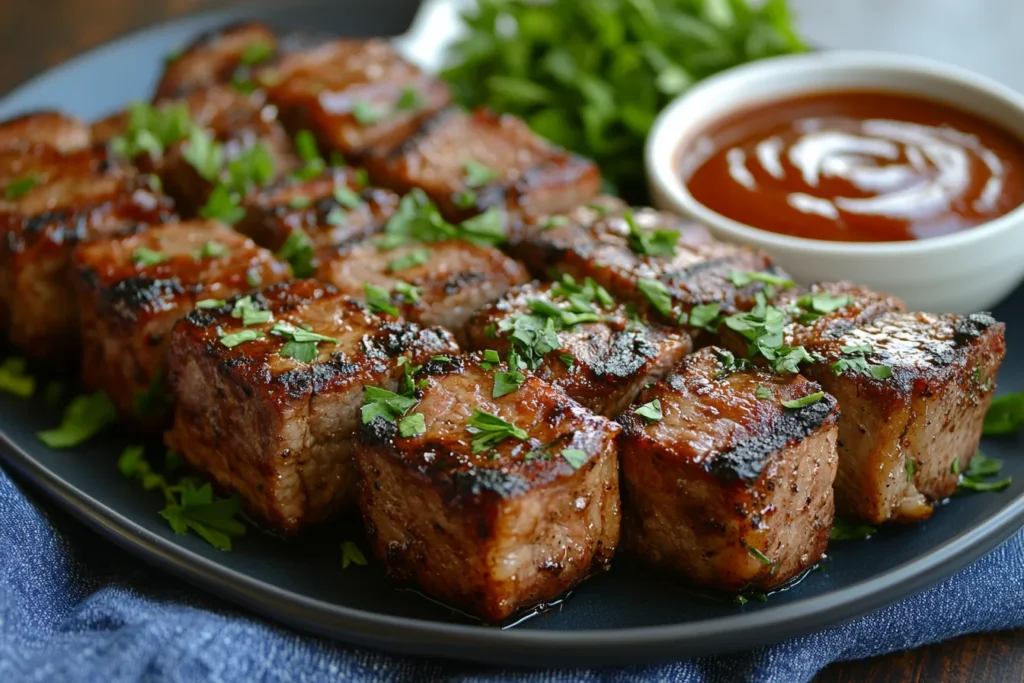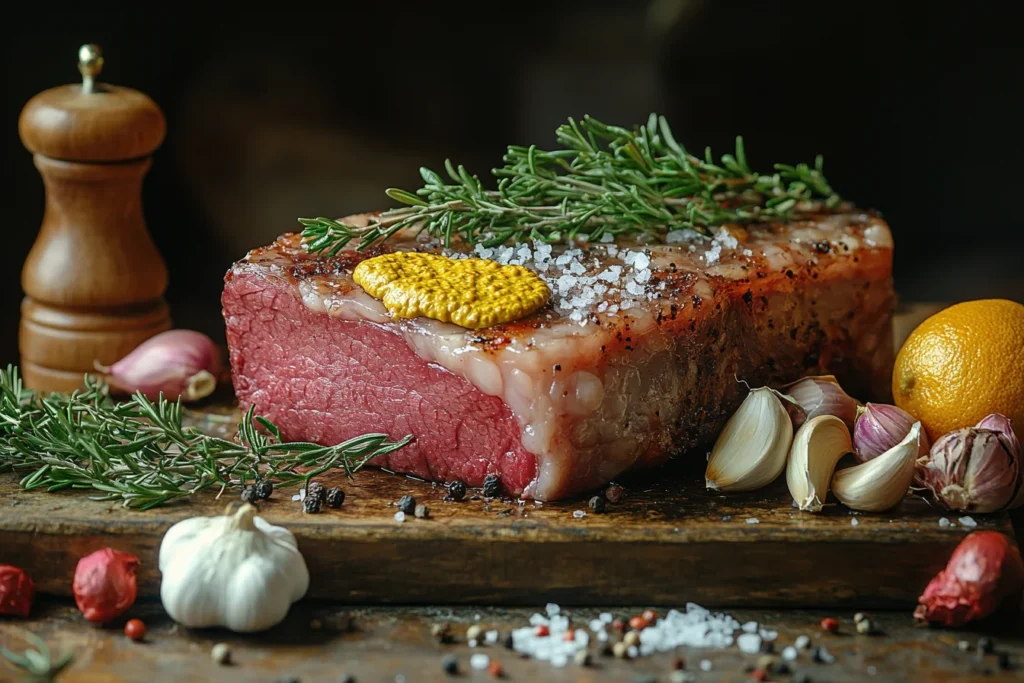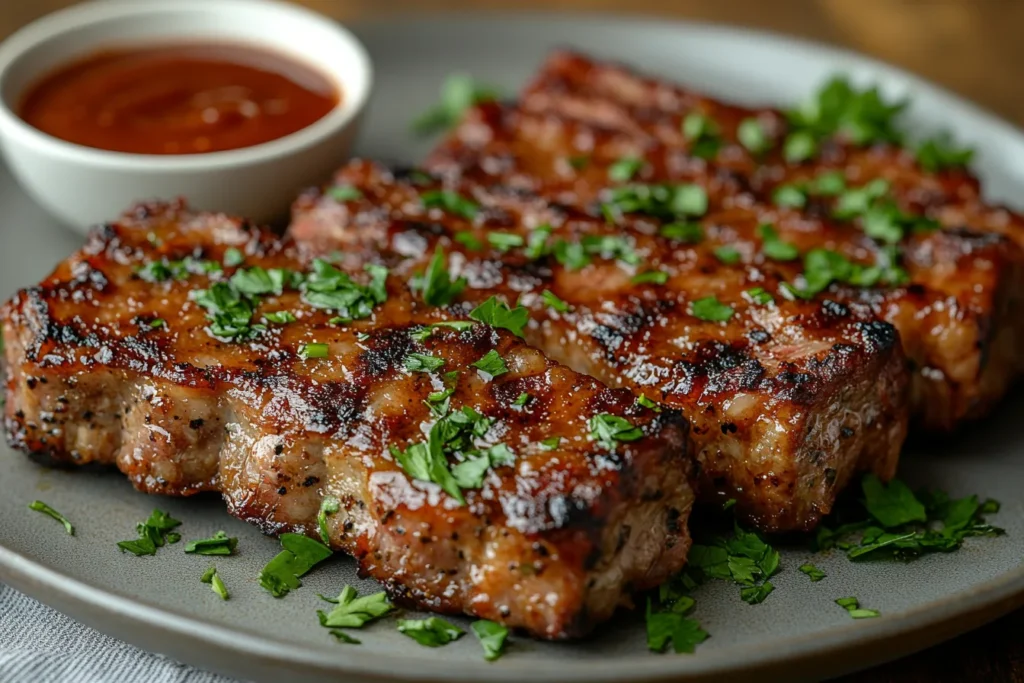Brisket is a prized cut of beef, known for its deep flavor and tender texture when cooked correctly. But to achieve the perfect bark and taste, one essential question arises: how do you get seasoning to stick to brisket? Whether you’re a seasoned pitmaster or new to BBQ, understanding the right techniques can take your brisket game to the next level. Plus, if you’re looking for ways to enhance flavor, check out our Beef Bouillon Powder for Brisket Recipe or learn Can I Use Beef Bouillon Instead of Beef Broth? for even more tips to perfect your brisket. Let’s dig into the details!

Table of Contents
Understanding the Dynamics of Brisket Seasoning
Seasoning brisket isn’t just about sprinkling spices. It’s about ensuring that the flavors cling to the surface during cooking. The key lies in creating a surface that allows the rub to adhere without falling off.
Why Does It Matter?
When seasoning doesn’t stick, your brisket loses much of its flavor, especially as it cooks. This can leave you with bland meat instead of the bold, smoky flavors you’re aiming for.
To improve adhesion:
Start with a slightly damp surface.
Choose seasonings that complement each other and the meat.
Allow time for the rub to settle before cooking.
Getting the right balance ensures every bite of brisket is bursting with flavor.
The Science of Meat and Flavor Adhesion
How do you get seasoning to stick to brisket? Understanding the science of adhesion is the first step. Proteins, fat, and moisture on the meat surface play crucial roles.
The Role of Moisture
Moisture acts as a natural binder, helping the rub stick. However, too much moisture can create a slippery surface, making the seasoning slide off. The goal is to achieve a tacky layer, which helps the seasoning stay in place during cooking.
Tips to Manage Moisture:
Pat the brisket dry with a paper towel to remove excess liquid.
Lightly coat the surface with olive oil or mustard for a tacky base.
Protein and Surface Texture
Proteins on the surface of the brisket bond with the seasonings as they cook. Coarse salt in your rub can help break down these proteins, allowing flavors to penetrate deeper.
Selecting the Perfect Seasoning Blend
Choosing the right seasoning blend is essential when figuring out how do you get seasoning to stick to brisket. The ideal blend enhances the brisket’s natural flavor without overpowering it, creating a balanced, flavorful bark.
Start with the basics. Salt and pepper form the foundation of most brisket rubs. Coarse kosher salt and freshly cracked black pepper not only provide flavor but also help the rub adhere better by gripping the meat’s surface. From there, you can customize the blend to your taste.
For a traditional Texas-style brisket, keep it simple with just salt, pepper, and maybe a hint of garlic powder. If you want more complexity, add smoked paprika for a subtle smoky sweetness or cayenne pepper for a touch of heat. Brown sugar is another great addition, helping the bark caramelize during cooking.
Texture matters, too. A combination of coarse and fine ingredients ensures better adhesion and even coverage. Coarse salt and spices grip the meat, while finer powders fill in gaps for a cohesive layer.
No matter the blend, remember to taste your mix before applying. A well-balanced rub is the secret to making brisket unforgettable and ensuring every bite is packed with flavor.
Preparing Brisket for Seasoning
The key to flavorful brisket starts long before the rub is applied. How do you get seasoning to stick to brisket? Proper preparation ensures the seasoning clings and flavors the meat evenly during cooking.
Step 1: Trim the Brisket
Begin by trimming the brisket. Remove excess fat, but leave about 1/4 inch of the fat cap for moisture and flavor. This step prevents fatty areas from blocking the rub’s contact with the meat. Be sure to cut away any silver skin, as it doesn’t render during cooking and can keep the seasoning from adhering.
Step 2: Pat Dry
Damp surfaces make seasoning slip off, so pat the brisket dry with paper towels. Removing excess moisture ensures better adhesion, especially if you’re using coarse ingredients in your rub.
Step 3: Apply a Binder
Use a thin layer of binder to create a tacky surface for the seasoning. Common choices include mustard, olive oil, or even Worcestershire sauce. These don’t alter the flavor significantly but provide the perfect grip for the rub.
Step 4: Let It Rest
After applying the binder, allow the brisket to sit for a few minutes. This step ensures the binder sets and creates an ideal base for your seasoning to stick firmly.
Creating a Moisture “Tack” for Seasoning
One of the secrets to getting seasoning to stick to brisket is creating the right moisture “tack” on the surface. This subtle stickiness ensures the seasoning clings evenly, helping it stay put during the long cooking process.
Why Moisture Matters
Moisture acts as a natural adhesive for seasonings. However, too much liquid makes the rub slide off, while a completely dry surface won’t hold the spices well. The goal is to strike a balance by creating a slightly tacky surface.
Steps to Achieve the Perfect Tack
Pat the Brisket Dry: Start by removing excess moisture with a paper towel. This avoids a slippery surface while still leaving enough natural dampness for adhesion.
Add a Binder: Lightly coat the brisket with a binder like mustard, olive oil, or even honey for a touch of sweetness. These create the ideal tacky layer without overpowering the flavor.
Let It Set: After applying the binder, give it a few minutes to settle. This helps the moisture bond with the surface, enhancing its stickiness.
Applying the Rub: Techniques and Tips
Mastering the rub application is crucial when asking how do you get seasoning to stick to brisket? The way you apply the rub affects flavor distribution and how well the seasoning adheres during cooking. Here’s how to do it right.
Step 1: Evenly Coat the Surface
After prepping the brisket and adding a binder, sprinkle the rub generously over the surface. Hold your hand about 12 inches above the brisket to allow for an even spread. Start with one side, patting the rub gently into the meat without rubbing aggressively. Flipping and repeating ensures every inch is covered.
Step 2: Press, Don’t Rub
Instead of scrubbing the spices into the meat, use a pressing motion. This helps the seasoning stick without dislodging other ingredients or disrupting the meat’s surface texture.
Step 3: Layer in Stages
Consider applying your rub in stages to ensure complete coverage. Start with salt and sugar to create a base layer, followed by your spice mix for enhanced flavor.
Step 4: Rest Before Cooking
Let the seasoned brisket sit for 30–60 minutes before cooking. This resting period allows the rub to bond with the binder, ensuring it sticks through the entire cooking process.

Resting and Absorption: Key Steps
After applying the seasoning, resting the brisket is a crucial step in getting the rub to stick and flavors to penetrate. This process, often overlooked, ensures your brisket develops a flavorful bark and a well-seasoned taste throughout.
Why Resting Matters
When you ask how do you get seasoning to stick to brisket, the resting phase plays a key role. It allows the salt and other spices in the rub to draw out moisture from the brisket’s surface, which then combines with the seasoning to form a sticky paste. This adhesion prevents the rub from falling off during cooking.
Steps for Resting and Absorption
Let the Brisket Sit: After applying the rub, leave the brisket uncovered on a clean tray or board.
For smaller cuts: Rest for 30–60 minutes.
For larger cuts: Allow up to 2 hours.
Use Plastic Wrap for Extended Rests: If you’re prepping in advance, wrap the brisket tightly in plastic wrap and refrigerate. This ensures the rub stays intact and flavors absorb deeply into the meat.
Avoid Over-Resting: Too much resting time at room temperature can dry out the surface. Aim for a balance to maintain a tacky layer while preventing drying.
The Role of Temperature and Cooking Methods
Once your brisket is seasoned and ready, how you cook it plays a huge role in keeping the seasoning intact. Maintaining the right temperature and using proper cooking methods ensures your seasoning forms a delicious crust (known as the bark) without burning or falling off.
Low and Slow: The Golden Rule
The best way to cook brisket is low and slow, meaning at a temperature of 225°F to 250°F. Cooking at a steady, lower heat allows the rub to adhere and form a flavorful bark. High temperatures can scorch the seasoning, causing it to lose its grip and compromise the flavor.
Indirect Heat Cooking
For smokers or grills, indirect heat is ideal. By placing the brisket away from direct flames, you minimize the risk of the seasoning burning or sliding off due to excessive heat. Use a water pan to maintain a moist cooking environment, which helps keep the rub intact.
Avoid Excessive Handling
Frequent flipping or moving the brisket can disturb the seasoning layer. Place the brisket fat-side up or down (depending on your preference) and let it cook undisturbed as much as possible.
Wrapping for the Finish
Once the bark forms, you can wrap the brisket in butcher paper or foil to lock in moisture while preserving the seasoning layer. This step, known as the “Texas crutch,” also speeds up the final cooking phase.
Troubleshooting Common Seasoning Issues
Even with careful preparation, things can go wrong. Whether your seasoning slides off or fails to stick, identifying the problem is essential. Here’s how to address common seasoning issues and ensure your brisket comes out perfect.
- Rub Sliding Off
Cause:
Excess moisture on the brisket or an overly wet binder can cause the seasoning to slide.
Solution:
Pat the brisket dry with paper towels before applying the binder.
Use a thin, even layer of binder, such as mustard or oil, to create a tacky surface without over-saturating.
- Uneven Seasoning Coverage
Cause:
Applying the rub too quickly or unevenly can leave gaps, resulting in inconsistent flavor.
Solution:
Sprinkle the rub from a height of about 12 inches to ensure even distribution.
Gently press the rub into the brisket rather than rubbing aggressively.
- Rub Burning During Cooking
Cause:
High temperatures or direct flames can scorch the rub, ruining the flavor and texture.
Solution:
Cook at a consistent temperature of 225°F to 250°F.
Use indirect heat, and place a water pan in the smoker to maintain moisture.
- Rub Falling Off After Cooking Starts
Cause:
Frequent flipping or not letting the seasoning set before cooking can cause the rub to detach.
Solution:
Let the seasoned brisket rest for 30–60 minutes before cooking to allow the rub to adhere.
Minimize handling during the cooking process to avoid disturbing the bark.
Storage, Serving, and Final Touches
Once your brisket is cooked to perfection, proper storage and serving techniques ensure it retains its flavor and texture. Adding finishing touches enhances the overall experience, making your brisket unforgettable.
Storing Brisket
Short-Term Storage:
If serving within a few hours, wrap the brisket in butcher paper or foil and place it in a cooler lined with towels. This resting method keeps the meat warm and lets the juices redistribute for maximum tenderness.
Long-Term Storage:
Let the brisket cool to room temperature. Wrap it tightly in plastic wrap and aluminum foil, then store it in the fridge for up to 3–4 days. For longer storage, vacuum-seal and freeze it for up to 3 months.
Reheating Brisket
In the Oven: Preheat to 300°F. Wrap the brisket in foil with a splash of beef broth or water to keep it moist. Heat until warmed through.
On the Smoker: Place it back in the smoker at 225°F to retain the smoky flavor.
Serving Tips
Slice the brisket against the grain to ensure tender, easy-to-bite pieces.
Pair with classic BBQ sides like coleslaw, cornbread, or baked beans for a balanced meal.
Final Touches
Add a light drizzle of BBQ sauce if desired, but let the brisket’s natural flavors shine.
Sprinkle coarse salt or cracked pepper for added texture and a final flavor boost.

FAQs About Getting Seasoning to Stick to Brisket
How do you get seasoning to stick to brisket?
Use a binder like mustard or olive oil to create a tacky surface, then evenly press the rub into the meat. Let it rest for 30–60 minutes before cooking.
What is the best binder for brisket seasoning?
Mustard is a popular choice because it adds a slight tang without altering the flavor. Olive oil or Worcestershire sauce also works well.
Why does my rub fall off during cooking?
This usually happens if the brisket surface is too wet or if the rub wasn’t given time to set. Pat the brisket dry, apply the rub evenly, and rest it before cooking.
Can you season brisket the night before?
Yes! Seasoning overnight allows flavors to penetrate the meat. Wrap the brisket in plastic wrap and refrigerate it to keep the rub intact.
Conclusion
Perfectly pro brisket is the hallmark of wonderful BBQ, and mastering how do you get seasoning to stick to brisket is crucial for growing the wealthy, flavorful bark that everybody loves. From coaching to cooking, each step topics, and a little attention to element is going an extended way in achieving the first-rate effects.
The manner starts offevolved with right guidance. Trimming the brisket guarantees the rub can adhere without delay to the meat, heading off boundaries like extra fat or silver skin. Patting the surface dry and making use of a thin binder like mustard or olive oil creates the cheesy base needed for the seasoning to stick. Without this foundation, even the most nicely-balanced rub can slide off for the duration of cooking, leaving the brisket underwhelming in flavor.
Choosing the proper seasoning combination is equally important. A mix of coarse and best substances ensures that the rub adheres well whilst providing the proper stability of flavors. Salt and pepper stay the classic base, however adding elements like paprika, garlic powder, and brown sugar can take your brisket to the following level. Applying the rub evenly, urgent it gently into the surface, and letting it relaxation earlier than cooking are all important strategies for fulfillment.
The cooking process itself also plays a important role. A constant, low-and-slow temperature of 225°F to 250°F permits the rub to form a crust with out burning or falling off. Cooking with oblique warmness and keeping off excessive coping with at some stage in the technique assist the bark stay intact while growing a deep, smoky taste.
Lastly, don’t underestimate the value of resting and serving. Letting the brisket relaxation after seasoning and again after cooking guarantees that juices redistribute, at the same time as storage and reheating methods preserve the integrity of your tough work. When serving, slicing in opposition to the grain and including light completing touches like coarse salt or a drizzle of BBQ sauce can raise the dining revel in.
Achieving a superbly pro brisket isn’t complicated, but it does require persistence and interest to element. By following these steps, you’ll create a brisket that’s flavorful, soft, and noteworthy. Whether you’re cooking for circle of relatives, buddies, or a huge BBQ competition, understanding a way to get seasoning to stick to brisket guarantees each bite is as scrumptious as the ultimate.

